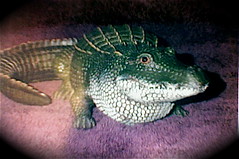
Did you know that when you toss out your empty plastic bottle of shampoo it hangs around the planet for a thousand years? I learned this lurid fact from Pam Longobardi, the other artist whose work is currently being exhibited along with Sue Johnson's (see my previous post) at the Maier Museum in Lynchburg. Pam was talking about her current project entitled "Drifters," whose subject happens to be plastic rubble. The inspiration (if inspiration is indeed the correct word) for this project arrived unexpectedly, when she discovered an enormous tangle of plastic fishing nets and other plastic debris while camping at a remote beach on the southernmost tip of the Big Island in Hawaii.
Attracted at first by the astonishing spectacle of the day-glo colors--almost a hallucination--and then by the lethal implications of what she was really seeing, it did not take long for Pam to realize that she had stumbled inadvertently into what she describes as "an environmental nightmare."
These fragments--combs that have lost their teeth, battered toys that look like gnawed bones, discarded flip-flops and mangled toothbrushes--were all heavy with rabid meaning. "Do you want to expose these scenes to the light?" Annie Dillard asks in "The Writing Life." "You may locate them and leave them, or poke the spot hard till the sore bleeds on your finger, and write with that blood...you can use its power for many years, until the heart resorbs it." Pam recognized this scene as a deadly portrait--of late capitalist global society and how we've fouled the ocean. She couldn't just leave it, but had to write with that blood for many years in order to share what she had witnessed.
She began by documenting the site with photographs and carrying out duffle bags filled with the plastic debris, intending to create art with what she'd found. Her subsequent creations made with plastic fragments are reminiscent of the work of English artist Tony Cragg, who also assembled found plastic remnants in the 1980s--but with a huge difference. Cragg's interest in plastic debris was entirely formalistic, engaged with the dazzling colors and eccentric shapes as a new form of art material. As Pam states: "In the '80s when Cragg was making pictures on the wall with garbage, plastic was fun. Now plastic is dangerous." It is the dangerous, degrading aspect of plastic that powers Pam's work, the crushing devastation hidden inside its gaudy allure.
In her by now extensive research, Pam has learned there exists in the Pacific a "garbage patch" of plastic the size of Texas. Thinking it is food, fish and birds eat these fragments, which then becomed embedded in their tissues and cause them to die. An oeceanic current called the North Pacific Gyre sweeps North, counterclockwise, up the coast of the Americas, west across the upper Arctic, south along the Asian coast, and then back toward the Hawaiian Islands--picking up debris along the way. It can take six years of riding the currents before the plastic arrives in the Gyre, and lands on that Hawaiian beach. Once there, however, it never leaves except as food ingested by members of the oceanic food chain. What was once an ordinary, functional object in human life has mutated into another kind of dark entity: trash.
"In a perverse continuation of the change of hands of commerce," Pam writes, "these objects circle the globe on oceanic currents, plied first by trade, then by trade winds....Joining Plant, Animal, and Mineral, we now must acknowledge a new kingdom, a Fourth Kingdom, the kingdom of Plastic, an army whose members never die or decompose, and threaten to outnumber all others."
On a mission of sorts, the artist is now planning a book about plastic and pollution that will encompass its artistic, scientific, and cultural aspects. In addition to her own work, the book will include essays by five other interdisciplinary contributers. More information about Pam's work can be found on her websites: www.driftwebs.com and www.pamlongbardi.com.

No comments:
Post a Comment